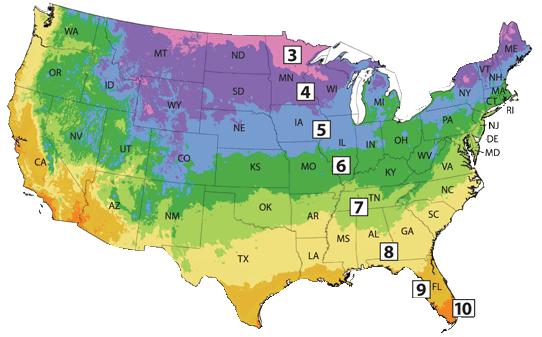All About Century Plants – Everything You Need to Know!
Updated: January 28, 2025

Century plants are a captivating group of plants that are part of the Agave genus, which belongs to the Asparagus family.
Before we continue, let's clarify the falsehood of the name Century plant. No, the century plant does not survive for a century. Actually, not even close. The majority of plants in the Agave genus are referred to as the century plants since people used to believe they only blossomed once every 100 years. In actuality, they really should be called quarter century plants as most only live for 25 to 30 years.
The term "century plant" refers to more than one species of agave, just as the word "pine" can refer to various species of coniferous trees.
A Closer Look at the Agave Century Plants
Agave is a diverse genus with over 200 species, each with its own unique characteristics in terms of size, color, and growth habit.
Among all the types of Agaves, the Agave americana, is the main plant normally referred to as the "century plant"; but there are a lot more agave varieties that share similar characteristics and may also be colloquially referred to as Century plants.
In a nutshell “All Century plants are a type of Agave, but not all Agave are Century Plants.”
While Agave Americana is indeed the most well-known and iconic century plant, it's fascinating to discover that there are other lesser-known types of century plants out there. Below, you can explore our top 16 favorite century plants for you to add to your home or garden.

What Makes the Century Plant So Special?

The century plant, also known as the Granddaddy of Agaves, mostly because it can get so big, their spiny leaves can reach 6 feet in height and 10 feet in diameter; basically the size of a mid-sized car!
Their towering bloom, which can reach up to 30 feet into the sky, is their most striking characteristic. The blooms of century plants are a rare sight, as the stalks usually don't appear until the plant is between 10 and 30 years old.
They have lance-shaped leaves that grow in a symmetrical pattern from a rosette, and they can store water in their leaves, which helps them survive in dry environments. Century plants are unique and hardy succulents that add a touch of beauty to any landscape.
Additionally, century plants, with their striking architectural forms, vibrant colors, and sometimes unusual leaf shapes, bring a touch of exotic beauty to any setting. Their ability to thrive in arid conditions and require minimal maintenance makes them popular choices for water-wise landscaping and drought-tolerant gardens. Overall, the combination of their longevity, striking appearance, and adaptability to various environments contributes to the special allure of century plants.
The Fascinating Process of Blooming Century Plants
The blooming of a century plant is truly a sight to behold. These majestic succulents spend many years growing and storing energy in their thick, fleshy leaves.
When the time is right, usually after 10 to 30 years, they begin their ascent towards the sky.
A tall flowering stalk emerges from the center of the plant, reaching impressive heights of up to 30 feet.
As the stalk grows, it produces numerous branches, each adorned with clusters of beautiful flowers. These century plant flowers can vary in color, ranging from vibrant yellows to rich oranges and reds.
The blooms attract pollinators like bees, hummingbirds, and bats, who play a crucial role in the plant's reproduction.

Once the century plant has completed its blooming process, it gradually begins to start dying off. However, fear not! Before it fades away, it produces "pups" or offshoots around its base, ensuring the continuation of its legacy.
What makes them truly special is their fascinating blooming lifecycle – about 99% of them are 'monocarpic' plants. This means it puts all its energy into producing a spectacular flowering stalk just once in its lifetime, before gracefully bowing out. While the rest is ‘polycarpic’ which means they don't die after blooming.
The blooming of a century plant is a true testament to the marvels of nature and the patience required to witness such a remarkable event. It's a reminder that beauty often comes with time and can be worth the wait.

We Love Century Plants – Here are Out Top 16 Favorite Varieties
The stunning century plants not only add a touch of elegance to any space but are also incredibly low-maintenance.
Below, we have listed the top 16 favorite century plants including the lesser-known century plant species, showcasing their unique features and breathtaking allure. After this list, you will also learn how to care for these magnificent plants.

1
Century plant (Agave americana)
BUY AT PLANET DESERTkeypoints:
- USDA Hardiness Zones: 8,9,10,11
- Mature Size: 6 ft. tall—12 ft. wide
- Specia Features: Drought tolerant, Mild frost tolerant, Pest resistant
- Flower Color: Greenish Yellow
The Agave americana is the most popular type of century plant. It has some unique features that make it a standout in any garden. First off, its rosette shape and long, spiky leaves give it a striking and dramatic appearance. It's like having a living sculpture in your yard. Additionally, it's a tough cookie that can handle tough conditions, making it perfect for rock gardens and xeriscapes. This monocarpic plant native to the Americas typically blooms after 10–30 years, bearing yellow-green flowers that attract pollinators and produce over 20 gallons of nectar per week. This Agave century plant can be propagated using offsets or seeds, but it requires more time and patience. Learn more.....
The Agave Americana has been used for centuries by various cultures because of its special characteristics:
- The leaves of this remarkable plant contain strong fibers that can be harvested and woven into ropes, mats, and even clothing.
- The sap of Agave Americana, known as aguamiel, can be fermented to produce a traditional alcoholic beverage called pulque. This plant has truly been a valuable resource for different communities throughout history, showcasing its practicality and cultural significance.
- Agave Americana is also known for producing a significant amount of nectar. It's fascinating to think that it can produce around 20 gallons of nectar per week. That's a lot of sweetness for the pollinators to enjoy

2
Foxtail Agave (Agave attenuata)
BUY AT PLANET DESERTkeypoints:
- USDA Hardiness Zones: 9, 10, 11
- Special Features: Drought tolerant, heat tolerant, pet friendly
- Mature Size: 4 ft. tall, 7 ft. wide
- Flower Color: Greenish Yellow
The Foxtail Agave is another century plant, that stands out with its elegant and curved leaves, resembling a graceful foxtail. Unlike many other agave species, Agave attenuata lacks the typical sharp spines along its leaves, making it a safer and more user-friendly choice for gardens and landscapes. This unique agave species is prized for its architectural form and the way its leaves gently arch and cascade, creating a visually appealing and tropical look. The Foxtail Agave's soft, lush green foliage adds a touch of elegance to any garden setting, making it a popular choice for both enthusiasts and landscapers alike. Learn more....
3
Agave Blue Glow
BUY AT PLANET DESERTkeypoints:
- USDA Hardiness Zones: 9, 10, 11
- Special Fearures: Drought tolerant, Easy to care for, heat tolerant
- Mature Size: 2 ft. tall, 3 ft. wide
- Flower Color: Greenish, Yellow
The Blue Glow Agave is also a stunning century plant that belongs to the Agave genus. This particular agave hybrid is a cross between Agave attenuata and Agave ocahui. It inherits some of the desirable traits from both parent plants, such as the smooth, spineless leaves of Agave attenuata and the compact, symmetrical rosette shape of Agave ocahui. Agave Blue Glow is characterized by its striking blue-green leaves that often exhibit a subtle glaucous or powdery coating, adding to its beauty. This agave is a popular choice for landscaping due to its attractive coloration and compact growth habit, making it a lovely addition to gardens and drought-tolerant landscapes. Learn more...

4
Variegated Century Plant (Agave americana 'Variegata')
BUY AT PLANET DESERTkeypoints:
- USDA Hardiness Zones: 8,9,10,11
- Mature Size: 6 ft. tall—10 ft. wid
- Special Features: Drought tolerant, mild frost tolerant
- Flower Color: Greenish Yellow
This gorgeous, variegated century plant is a perfect choice as a focal point in a rock garden. Its unique variegated leaves, with their vibrant green color and delicate creamy white or yellow edges, create a stunning contrast against the rugged rocks. Being monocarpic, the blooming period of the variegated century plant is relatively short, usually lasting only a few weeks. However, during this time, the plant becomes the star of the rock garden, capturing everyone's attention with its grandeur. Learn more.....

5
Blue Agave Century Plant (Agave tequilana)
BUY AT PLANET DESERTkeypoints:
- USDA Hardiness Zones: 9,10,11
- Mature Size: 6 ft. tall—10 ft. wide
- Special Features:Highly drought tolerant, Easy to care for, heat tolerant
- Flower Color: Yellow
The Blue Agave (Agave tequilana) is the plant used to make tequila. This striking century plant features blue-green leaves with serrated edges, forming symmetrical rosettes. The blue agave century plant is a monocarpic species, which means it blooms only once in its lifetime. After many years of growth, usually between 10 to 25 years, a tall flower stalk shoots up from the center of the plant. This stalk can reach impressive heights, sometimes up to 30 feet. Learn more.....

6
White Stripe Century Plant (Agave ‘Mediopicta Alba')
BUY AT PLANET DESERTkeypoints:
- USDA Hardiness Zones: 8,9,10,11
- Mature Size: 8 ft. tall—8 ft. wide
- Special Features:Drought tolerant, mild frost tolerant, Easy to care for
- Flower Color: Pale Green, Red, Yellow
The white stripe century plant is a beautiful succulent with striking white stripes running along its leaves. These white stripes create a visually appealing contrast against the green foliage, making it a stunning addition to a rock garden. When planted alongside other plants in a rock garden, the Agave medio-picta alba adds a touch of elegance and texture to the overall landscape. The white stripe century plant, a monocarpic perennial, blooms once a lifetime, attracting pollinators with its tall yellow clusters and adding vibrant color to the garden. Learn more.....

7
Quadricolor Century Plant (Agave lophantha Quadricolor)
BUY AT PLANET DESERTkeypoints:
- USDA Hardiness Zones: 8,9,10,11
- Mature Size: 2 ft. tall—2 ft. wide
- Special Features: Drought tolerant, Easy to care for
- Flower Color: Greenish yellow
The quadricolor century plant has green leaves in the center, which are edged with beautiful yellow, red, and cream. This color combination creates a striking contrast and adds visual interest to any garden or landscape. Agave lophantha, a monocarpic plant, blooms once, producing tall, yellow flowers. Offsets, or "pups," can be separated and replanted to maintain their beauty in gardens. Learn more.....

8
Thorn Crested Agave (Agave lophantha 'Splendida')
BUY AT PLANET DESERTkeypoints:
- USDA Hardiness Zones: 7,8,9,10
- Mature Size: 3 ft. tall—3 ft. wide
- Special Feature:Drought tolerant, Mild frost tolerant, Pest resistance
- Flower Color: Greenish yellow
The thorn crested agave, like many other agave century plants, is also monocarpic. When the plant reaches maturity, a tall flower stalk shoots up from the center, reaching impressive heights. Agave lophantha, like other agave plants, produces offsets or "pups" around its base that can be separated and replanted to maintain its beauty in your garden. Learn more.....

9
Ocahui Century Plant (Agave Ocahui)
BUY AT PLANET DESERTkeypoints:
- USDA Hardiness Zones: 8,9,10
- Mature Size: 3 ft. tall, 3 ft. wide
- Special Features: Drought tolerant, Easy to care for, mild frost tolerant
- Flower Color: Bright yellow
The Ocahui century plant is a striking succulent that hails from Mexico. This century plant known for its rosette of thick, spiky leaves that grow in a symmetrical pattern. These leaves are a beautiful shade of blue green, adding a cool and calming touch to any garden or landscape.
Native to Mexico, Agave Ocahui thrives in hot, dry climates and requires minimal water once established. Its drought-tolerant nature makes it an ideal choice for xeriscaping or low-maintenance gardens. Agave ocahui, like other century plants, takes its time to bloom. When it does, a tall flower stalk emerges from the center of the rosette, reaching heights of up to 15 feet. This impressive display of flowers attracts pollinators and adds a dramatic focal point to the plant. Learn more.....
10
Hedgehog Century Plant (Agave stricta)
BUY AT PLANET DESERTkeypoints:
- USDA Hardiness Zones: 9, 10, 11
- Mature Size: 20 in. wide
- Special Features: Polycarpic, Drought tolerant, heat tolerant, Easy to care for
- Flower Color: Green, reddish-brown, purple
The Hedgehog agave is one of the few century plants that is polycarpic, meaning it bloom more than once in a lifetime. This unique feature sets it apart from other agave species and adds to its charm as a striking ornamental plant with its hedgehog-like appearance. It gets its nickname from the spiky and clustered arrangement of its leaves, resembling a hedgehog's spines. Learn more...

11
Havard’s Century Plant (Agave havardiana)
keypoints:
- USDA Hardiness Zones: 5,6,7,8,9,10
- Mature Size: 3 ft. tall, 5 ft. wide
- Special Features: Drought tolerant, Easy to care for, mild frost tolerant
- Flower Color: Bright yellow
The Havard’s Century Plant has gained popularity among succulent lovers and plant enthusiasts. Its unique appearance, with its rosette of thick and fleshy leaves, along with its impressive flowering display, makes it a favorite among collectors. Many people appreciate the architectural beauty and resilience of this agave, as it can tolerate cold temperatures and still thrive. Similar to other century plants, it takes several years for this agave to reach maturity and produce a flower stalk. Agave havardiana is a stunning succulent that can be found in the desert regions of Texas, New Mexico, and northern Mexico. It's named after botanist Valery Havard, who studied the flora of the American Southwest.

12
Dwarf Century Plant (Agave Desmettiana)
BUY AT PLANET DESERTkeypoints:
- USDA Hardiness Zones: 8,9,10
- Mature Size: 4 ft. tall, 4 ft. wide
- Special Features: Drought tolerant, Easy to care for
- Flower Color: Yellow
The dwarf century plant (Agave desmettiana) is a small to medium-sized succulent that hails from Mexico. It is a striking succulent plant with long, narrow leaves that are a silvery-green color and edged with sharp teeth. This plant is drought-tolerant and low-maintenance, making it a popular choice for landscaping in arid climates. It's a reminder of the beauty and transience of nature, and it's a joy to witness this remarkable display in person.

13
Maguey Pajarito (Agave ornithobroma)
keypoints:
- USDA Hardiness Zones: 8,9,10,11
- Mature Size: 3 ft. tall, 5 ft. wide
- Special Features: Polycarpic, Drought tolerant, Easy to care for, mild frost tolerance
- Flower Color: Yellow
The Maguey Pajarito has thick and fleshy leaves, with a blue-green hue. They are armed with spiky edges, so you'll want to be careful when handling them. This agave can grow to be quite large, with a rosette shape that adds a dramatic touch to any landscape.
Unlike the other century plant, Agave ornithobroma is polycarpic. This means that it can flower multiple times throughout its life. So, you get to enjoy the beautiful flowers more than once. Its flower stalk can reach impressive heights, showcasing clusters of vibrant yellow flowers. These flowers are not only a treat for the eyes but also attract pollinators like hummingbirds and butterflies, adding a touch of natural beauty to any garden.

14
Sisal Century Plant (Agave sisalana Mediopicta)
BUY AT PLANET DESERTkeypoints:
- USDA Hardiness Zones: 9,10,11
- Mature Size: 6 ft. tall
- Special Features: Drought tolerant, Heat tolerant, Pest resistance
- Flower Color: Yellow
The sisal century plant is a spiky succulent from Mexico. Agave desmettiana is a lesser-known species prized for its soft, flexible leaves and rapid growth rate. Unlike many other agave species, it lacks sharp spines, making it a safer option for gardens with pets or children. Its graceful, arching foliage adds a touch of tropical flair to any landscape. It takes around 8 to 15 years to mature and produce a tall flower stalk. Like other monocarpic, after blooming, it produces offsets or "pups" that can be replanted. It's a visually striking plant with tough leaves used to make sisal. Learn more.....

15
Variegated Caribbean Agave Century Plant (Agave Angustifolia marginata)
BUY AT PLANET DESERTkeypoints:
- USDA Hardiness Zones: 10,11
- Special Features: Drought tolerant, heat tolerant, Easy to care for
- Mature Size: 5 ft. tall, 6 ft. wide
- Flower Color: Greenish Yellow
The Caribbean agave century plant, native to Mexico, known for its slender, elongated leaves. Traditionally used in the production of mezcal, this versatile agave is also prized for its ornamental value. With its gracefully arching foliage and moderate size, it adds glory to desert landscapes. Learn more.....
We hope the above list will help you find the perfect century plants for your home or garden. It's always exciting to add some greenery to your space and can really bring a fresh and vibrant touch to any room.
General Care Guide for Century Plants
Despite being simple to grow, agave plants do require a few "needs" in order to be healthy. Below, you can find out more about how to take care of your century plants.
Quick Reference

Bloom Season

Flower Color

Growth Rate

Hardiness Zone

Mature Size

Plant Type

Sun Exposure

Toxicity

Watering Needs
How to Water a Century Plants - Tips & Tricks
When it comes to watering century plants, it's best to follow a "soak and dry" approach. This means you should thoroughly water the plant and then allow the soil to dry out completely before watering again. Typically, watering once every two to three weeks is sufficient, but it can vary depending on factors like the climate and soil conditions. It's important to avoid overwatering century plants, as this can lead to root rot. Ensure that the soil is well-draining and allow the top few inches to dry out before watering again.
Remember, it's always a good idea to observe your plant and adjust the watering schedule based on its specific needs.
Spring Watering Schedule:
- As the weather warms up, increase the frequency of watering
- Make sure to water deeply to encourage healthy root growth.
- Keep an eye on the moisture levels in the soil and adjust watering accordingly.
Summer Watering Schedule:
- During hot and dry periods, water your century plants more often.
- Give them a good, deep watering to ensure the water reaches the root zone.
- Consider using mulch around the plants to help retain moisture and regulate soil temperature.
Fall Watering Schedule:
- As temperatures start to cool down, reduce the frequency of watering.
- Allow the soil to dry out slightly between waterings.
- Keep an eye on rainfall and adjust your watering routine accordingly.
Winter Watering Schedule:
- During the winter months, water your century plants sparingly.
- Avoid overwatering, as this can lead to root rot.
- Monitor the moisture levels in the soil and only water when necessary.
Remember, these tips are general guidelines, and it's important to observe your century plants and adjust your watering routine based on their specific needs and the conditions in your area.
Ideal Sunlight Requirements for Century Plants
For indoor century plants, it's important to place them near a bright and sunny window where they can soak up direct sunlight for at least 6 hours a day. They absolutely love basking in the sun. If your indoor space doesn't receive much direct sunlight, don't worry. You can always supplement their light needs with artificial grow lights. These lights mimic the sun's rays and provide the necessary light intensity for your century plant to thrive. Just make sure to rotate the plant regularly so that all sides receive equal exposure to the light. This will prevent it from leaning towards the light source and keep it growing straight and strong.
When growing outdoors, they thrive in full sunny conditions, so it's best to find a spot in your garden that receives direct sunlight for most of the day. Make sure there are no nearby structures or trees that could cast shade on the plant and block out the sunlight. While century plants can tolerate some shade, they will grow their best in full sun. However, if you live in an area with scorching hot summers, it might be beneficial to provide some afternoon shade to protect the plant from intense heat. This will help prevent sunburn and keep your century plant happy and healthy.

Remember, every plant is unique, and it's important to observe your century plant and adjust its sunlight exposure based on its individual needs. With the right amount of sunlight, your century plant will flourish and bring a touch of natural beauty to your space, whether it's indoors or outdoors!
The Perfect Recipe: Best Soil & Fertilizer for Thriving Century Plants
When it comes to choosing the right soil and fertilizers for your adorable agave century plants, you need to be extra cautious and need to use the right kind of soil. Moisture can be a real killer, leading to root and stem rot in no time flat. But fear not, my fellow green thumbs!
Planet Desert has got your back with our specialized succulent potting mix that includes 5 natural substrates with organic mycorrhizae – perfect for promoting healthy roots and happy plants.
As an okay alternative, you can create your own potting mix by combining equal portions of perlite, coarse sand, and a good natural potting soil.
Century plants are known for their hardiness and can thrive with minimal fertilizer. In fact, encouraging flowering is not recommended, as the plant typically dies after it blooms.
To promote healthy growth, it's best to provide a minimum amount of fertilizer. You can use a balanced, slow-release fertilizer with a ratio of 5-10-5.

Apply the fertilizer sparingly in the spring, following the package instructions, and avoid over-fertilizing, as this can lead to weak growth and damage the plant.
Remember, century plants are naturally adapted to thrive in harsh environments, so they don't require excessive fertilization to grow beautifully. Focus on providing them with well-draining soil and the occasional light feeding, and they will reward you with their striking foliage and impressive stature.
Temperature and Humidity: Unlocking the Secrets to the Ideal Condition for Century Plants
When growing indoors, they do well in average room temperatures between 65°F and 75°F. Avoid exposing them to extreme temperature fluctuations, as this can stress the plant. Keep in mind that century plants can tolerate slightly cooler temperatures during their dormant period in winter.
Your agave century plants can tolerate a range of humidity levels, but they generally prefer moderate humidity. Aim for around 40% to 60% humidity. If the air in your home is dry, especially during winter months, you can increase humidity by using a humidifier or placing a tray of water near the plant. Misting the leaves occasionally can also help provide a bit of extra moisture.
For outdoor cultivation, they are well-suited for arid and semi-arid regions, and they thrive in hardiness zones 8 to 11. There are couple of agave century plants that are good in colder regions in the zone 7 or even less, like Agave parryi, Thorn crested agave, or Havard's agave. These zones are characterized by mild winters and hot, dry summers. Century plants are incredibly resilient and can tolerate high temperatures, drought conditions, and low humidity. They are excellent choices for xeriscaping, which focuses on conserving water in landscaping.

They are highly heat-tolerant and can withstand temperatures up to 100°F. They can also tolerate mild frost and temperatures as low as 20°F for short periods. However, providing some protection during extreme cold snaps is recommended to prevent damage to the plant.
Propagation Techniques for Century Plants:
The best time to propagate century plants is in the spring or fall. There are two main methods of propagating Century Plant: seeds and offestes. Each has its own set of benefits and unique characteristics.
Growing From Seeds:
- Century plants produce seeds after they flower and die.
- Collect the seeds from the dried flower stalk and remove any debris.
- Sow the seeds in well-draining soil, lightly covering them with a thin layer of soil.
- Keep the soil consistently moist but not waterlogged.
- It may take several weeks or even months for the seeds to germinate.
- Once the seedlings have grown large enough, you can transplant them into individual pots or directly into the garden.
Propagation by Offsets or Pups:
- Century plants produce offsets or pups, which are small plants that grow around the base of the mature plant.
- Wait until the offsets are at least one-third the size of the parent plant before separating them.
- Carefully remove the offset from the parent plant, ensuring that it has its own roots.
- Allow the offset to dry for a day or two to prevent rotting.
- Plant the offset in well-draining soil, burying it up to its base.
- Water the offset sparingly until it establishes its own root system.
A Guide to Pests & Common Issues for Century Plants
When it comes to possible pests and common problems with century plants, here are a few to watch out for:
Mealybugs: These tiny, white, cotton-like insects can infest century plants, sucking sap from the leaves and causing them to wilt or turn yellow. They can be quite pesky, but there are ways to deal with them.
Scale Insects: Scale insects are another common nuisance for century plants. They appear as small, oval-shaped bumps on the leaves or stems. They feed on plant sap and can cause yellowing, stunted growth, and leaf drop if left untreated.
Root Rot: Overwatering or poorly draining soil can lead to root rot in century plants. This fungal disease can cause the roots to become mushy and black, leading to wilting and eventual death of the plant if not addressed promptly.
Sunburn: Century plants love sunlight, but excessive exposure to intense rays can lead to sunburn. This can result in scorched or browned leaves, especially if the plant is suddenly moved to a location with direct sunlight without proper acclimation.
Agave Snout Weevil: These insects can cause serious damage, especially to mature plants preparing to bloom. To combat them, keep an eye out for signs of infestation and consider treatment options if necessary.
Leaf Spot: Unsightly spots on your Agave's foliage are often caused by fungi or bacteria thriving in warm, moist conditions. Keep the leaves dry to prevent this disease.
Remember, keeping an eye out for these pests and problems and taking proactive measures can help keep your century plant healthy and thriving.

Where to Buy Century Plants?
When it comes to buying century plants, unless you have a local nursery that specializes in cactus and succulents; then you may have a hard time finding agave century plants near you.
Most of the types of Century Plants listed above are all available here at Planet Desert. You can just click the buy link on any of the Century Plants on our list above, or feel free to explore more types of agave plants here.
We have the world's largest selection of Cactus & Succulents that can be shipped anywhere in the United States and are guaranteed to arrive happy & healthy.
Century Plants Quick Growing Reference Guide
| Bloom Season | Spring, Summer (Depending on the species) |
|---|---|
| Botanical Name | Several species of Agave |
| Common Name | Century Plants, American aloe, Maguey |
| Dormancy | Winter |
| Family | Asparagaceae |
| Flower Color | Golden yellow |
| Genus | Agave |
| Growth Habit | Upright |
| Growth Rate | Fast |
| Hardiness Zone | 5,6,7,8, 9, 10, 11 (Varies species to species) |
| Mature Size | 3 to 6 feet tall (Varies species to species) |
| Native Area | Mexico |
| Plant Type | Perennial succulent |
| Propagation | By pups, divisions |
| Resistance | Drought tolerant, heat tolerant, mildly frost tolerant, pest resistance |
| Soil PH | 6.5, Acidic, Neutral |
| Soil Type | Sepecialized Succulent potting mix soil |
| Special Features | Easy to care for |
| Sun Exposure | Full sun, partial shade |
| Toxicity | Mildly toxic to humans, mildly toxic to pets (Keep away from children) |
| Watering Needs | Low |
Final Thoughts
Overall, the century plants, encompassing different species of agave. They are remarkable and versatile plants that bring a unique charm to any garden or landscape. They spend many years growing and finally bloom with a magnificent flower stalk. After blooming, the parent plant dies, but it leaves behind pups or offshoots that grow into new plants. This process ensures the continuation of the species and provides an opportunity for propagation.
When it comes to care, they prefer well-drained soil and lots of sunlight, so finding a suitable location in your garden is important. Additionally, it's crucial not to overwater them, as they are adapted to survive in arid conditions. Regular pruning of dead leaves and protection from extreme cold temperatures can also help maintain their health and appearance.
By understanding the life cycle of century plants and providing them with the right care, you can enjoy their beauty and watch as new generations grow. It's a rewarding experience to witness the cycle of life in these remarkable plants!
Frequently Asked Questions
-
How often does a Century plant bloom?
Century plants have a unique blooming pattern. The majority of century plants, about 99%, are monocarpic, which means they bloom only once in their lifetime. This spectacular blooming event typically occurs after 10 to 30 years of growth, depending on the species and environmental conditions. Once a monocarpic century plant blooms, it puts all its energy into producing a magnificent flower stalk that can reach impressive heights. The flowering process can take several weeks or even months, and the plant puts on a breathtaking display of flowers before eventually withering and dying. While there is a small percentage, around 1%, of century plants that are polycarpic. These polycarpic species have the ability to bloom multiple times throughout their lifetime. However, their blooming frequency is much less predictable compared to monocarpic species.
-
Are Century plants toxic to pets?
The century plants have extremely thick skin, and animals would have to struggle to expose the sap, which would only make them sick rather than dye them. The outside of the leaves is non-toxic, but if your animal bites hard, it may be exposed to some of the sap, which would make them mildly sick. Be mindful of their sharp spines and handle them with care around pets.
-
How do I propagate a Century plant?
Pups are offshoots of mature century plants that grow around their base. To propagate them, separate them from the parent plant, remove soil, and cut them away. Allow the cut end to dry before planting in well-draining soil. Seeds are another option but require more patience and effort. Collect seeds from a mature plant after blooming and plant them in a well-draining soil mix. Allow the seeds to germinate for several weeks or months, then care for them until they are large enough to be transplanted.
-
How do you take care of Century plants?
- Agave century plants love bright sunlight, so find a location where they can receive at least six hours of direct sunlight each day.
- Century plants are drought-tolerant plants, so they don't require frequent watering.
- Use a well-draining soil mix specifically designed for succulents or cacti. This helps prevent waterlogged soil and promotes healthy root growth.
- They are generally hardy and can tolerate a range of temperatures. However, they prefer warm temperatures between 65°F and 75°F and may need protection from frost or extreme cold.
- They don't require much fertilization. You can use a balanced (5-10-5), slow-release NPK fertilizer during the growing season.
- Agave century plants don't require regular pruning. However, you can remove any dead or damaged leaves by cutting them close to the base of the plant.
-
Is Agave Century Plant a cactus or succulent?
The Century plant, like all species within the Agave genus, is classified as a succulent, not a cactus. While cacti and succulents have a lot in common, such as their ability to retain water in their leaves or stems, but they belong to different botanical families. Cacti belong to the family Cactaceae, while Century plants and other succulents belong to various families, including Asparagaceae and Agavaceae.
-
What happens to a century plant after it blooms?
Once the century plant has bloomed, it will begin to produce seeds. After the seeds are formed, the parent plant will gradually start to decline and eventually die. This is a natural part of the plant's life cycle. However, before it dies, the century plant may produce "pups" or offshoots around its base. These pups can be separated from the parent plant and propagated to continue the cycle. It's important to note that the name "century plant" can be a bit misleading because the plant doesn't actually live for a century. The name comes from the fact that it takes a long time (often many years) for the plant to reach maturity and bloom.






















